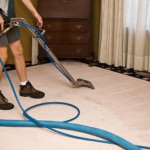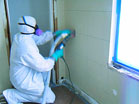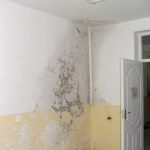Mold spores are common in the natural environment. The fungi are especially useful in the great outdoors, breaking down decomposing natural elements. Some molds are even used to make penicillin.
Dangers of Mold
When mold latches onto areas inside your home, however, the consequences are dire. Ill health effects, like sneezing, coughs, respiratory issues, skin rashes, runny nose, and watery eyes are all symptoms of mold inside the home. Humans are not only negatively affected by mold spores, but the property is also at risk.
Structural Damage
Mold eats away at building materials, such as drywall and wood, leading to weakened structures. The property value plummets to zero, once mold has become an issue. Adding to the disaster is that in 44 states, insurance does not cover damages directly caused by mold growth.
Spores that become airborne can be dormant for 50 years. Mold starts to thrive when water is present. Moisture is the primary nutrient for mold, especially when an additional organic food source is also available. The humid indoors, with temperatures from 40 to 100 degrees, give mold a comfortable place to grow.
How to Test for Mold
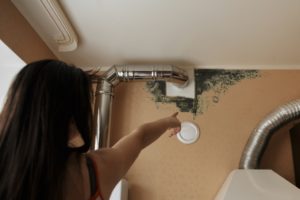
Mold growth inside a property must be eliminated immediately. Testing for mold inside the home identifies any suspect growths as mold. The first step is to recognize when mold is flourishing inside your home. Homeowners will then want to use any of the methods below used to test for mold growth.
Identify Mold
Mold can oftentimes be identified visually. Black spots growing along a wall can be a solid indication of mold. These ugly black splotches can expand into gigantic mold colonies if not addressed right away.
A musty odor in an enclosed area that has recently undergone water damage, such as a leak, is another sign of possible mold growth. Some experts liken the musty odor of mold to the smell of dirty socks.
Health issues, like those mentioned, that arise more frequently when a home’s occupants are indoors is another solid indication that mold is an issue.
Common areas that mold finds as habitable include attics, basements, crawl spaces, bathrooms and kitchens. These are all areas where moisture and condensation accumulate recurrently.
Test for Mold
A mold test is recommended when you smell mold but cannot visually detect it or find out where the mold colonies are growing. When mold is apparent, but the severity of the infestation is unknown, a mold test will help determine the extent of the growth. Mold testing is also ideal when you are attempting to pinpoint the water source causing the mold growth. A homeowner buying or selling a home will likely want to conduct a mold test. Even if you see a large infestation of mold, a professional mold inspection will help the homeowner develop a formal strategy to remove it.
Homeowners may believe in error that the mold should be tested to determine the species of mold and to assess whether they are harmful or not. In actuality, any mold growth inside the home is dangerous and should be removed right away.
As a national average, a mold test can cost a homeowner $673, with the typical range falling between $295 and $1,060. On the low end, a mold test runs at $145. On the higher end, the mold test can be a steep $2,663.
Mold Testing Kits
Mold test kits are cost-effective ways to test for mold growth inside the home. Kits are readily available at local hardware stores. You’ll want to purchase a DIY mold test kit that meets EPA standards and is approved by the National Association of Mold Professionals.
Kits are easy to use and detect the presence of mold inside the home. Most kits come with a petri dish that a homeowner can set out to determine the presence of mold.
Opponents to mold test kits claim that results may be inaccurate for several reasons. Mailing the petri dish to a lab for analysis leaves the package susceptible to humidity, handling, and time—all which affect the results. Plus, DIY kits fail to offer a thorough inspection, which involves the use of infrared cameras, moisture meters, and hygrometers that a professional mold inspector would use to find hidden mold growth.
Mold Detection Dogs
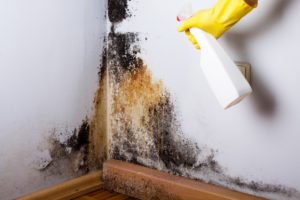
Hunting dog breeds, like Labradors and beagles, that are trained to detect mold can sniff out mold growth within a property. Dogs trained to identify mold are similar to those used to sniff out drugs, termites, and money.
Mold growth can often remain hidden, making mold detection dogs useful in locating the spores. Since mold spores feature a unique smell, mold detection dogs follow the scent and lead mold inspectors to the growth.
Mold Inspectors
A professional mold inspector will identify the mold as well as the moisture source causing the mold growth. Mold inspectors will offer an optional water assessment. Utilizing a moisture sensor and other equipment, the professionals will show the homeowner the location of the mold-causing moisture.
Mold Removal Services
Important to note is that if you hire a mold inspector, ensure any mold remediation service you subsequently hire is not associated with the mold inspector. The mold remediation service also should be certified and have a contractor’s license.
When mold infestations take a toll on your home, contact a dependable mold remediation company, such as ServiceMaster of St. Louis. The skilled technicians have years of experience and will eliminate all mold growth as well as prevent future mold outbreaks. The team employs advanced products and high-tech equipment to dislodge and eliminate mold growth, giving homeowners lasting results. Not only is the mold growing on various surfaces eliminated, but mildew spores are removed from the home as well.
Included in the company’s thorough mold removal services are an assessment of the existing mold infestation, complete removal of all mold and coordination of claims with the homeowner’s insurance. The specialists will arrive onsite right away to contain the mold and start the mold removal process.
ServiceMaster of Metro East reliably serves the home and business communities of St. Louis, MO and the surrounding communities.
